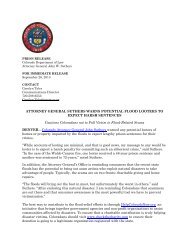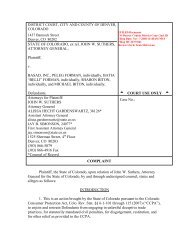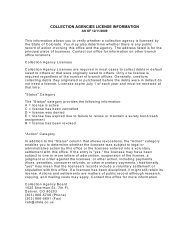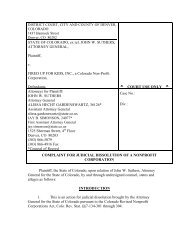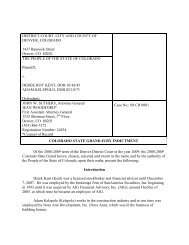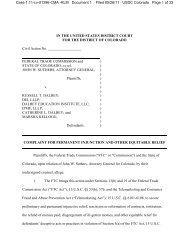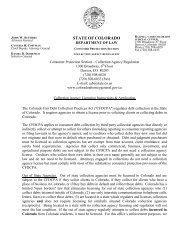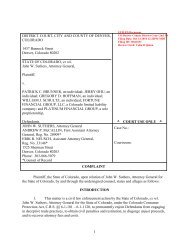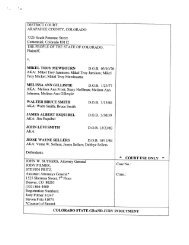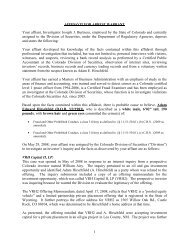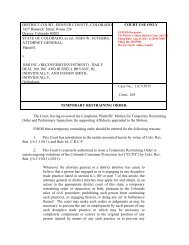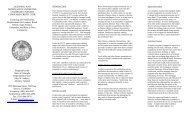brief in opposition to motion to dismiss - Colorado Attorney General
brief in opposition to motion to dismiss - Colorado Attorney General
brief in opposition to motion to dismiss - Colorado Attorney General
Create successful ePaper yourself
Turn your PDF publications into a flip-book with our unique Google optimized e-Paper software.
There is no basis <strong>to</strong> conclude that the term “thorough and uniform system of free publicschools” is beyond the comprehension of the judiciary. The idea that the Education Clause has asubstantive component is virtually <strong>in</strong>contestable. Lujan affirms that the phrase refers <strong>to</strong>educational “opportunities.” Id. In Fangman, the Supreme Court outl<strong>in</strong>ed the dimensions ofthose thorough and uniform opportunities, hold<strong>in</strong>g that by virtue of the Education Clause,statutes govern<strong>in</strong>g education should not be “narrowly and technically construed” <strong>to</strong> turn childrenaway from the school house “<strong>to</strong> grow up <strong>in</strong> idleness and ignorance,” but should be liberally andbroadly <strong>in</strong>terpreted” <strong>to</strong> further the purposes of educat<strong>in</strong>g children “<strong>to</strong> that degree that they cancare for themselves and act the part of <strong>in</strong>telligent citizens.” Fangman, supra, 8 P.2d at 311-312,quot<strong>in</strong>g McNish v. State, 74 Neb. 261, 263, 104 N.W. 186 (1905).In Lujan, the Court cites Pauley v. Kelley, 162 W.Va. 672, 255 S.E.2d 859 (1979) for a“thorough presentation of the education clauses <strong>in</strong> other states which are similar or identical <strong>to</strong><strong>Colorado</strong>’s ‘thorough and uniform’ requirement.” In that case, the West Virg<strong>in</strong>ia SupremeCourt, follow<strong>in</strong>g cus<strong>to</strong>mary standards of constitutional construction, def<strong>in</strong>ed both theconstitutional phrase “thorough and efficient” and identified its basic contents:We may now def<strong>in</strong>e a thorough and efficient system of schools: It develops, as best thestate of education expertise allows, the m<strong>in</strong>ds, bodies and social morality of its charges <strong>to</strong>prepare them for useful and happy occupations, recreation and citizenship, and does soeconomically.Legally recognized elements <strong>in</strong> this def<strong>in</strong>ition are development <strong>in</strong> every child <strong>to</strong> his orher capacity of (1) literacy; (2) ability <strong>to</strong> add, subtract, multiply and divide numbers; (3)knowledge of government <strong>to</strong> the extent that the child will be equipped as a citizen <strong>to</strong>make <strong>in</strong>formed choices among persons and issues that affect his own governance; (4)self-knowledge and knowledge of his or her <strong>to</strong>tal environment <strong>to</strong> allow the child <strong>to</strong><strong>in</strong>telligently choose life work -- <strong>to</strong> know his or her options; (5) work-tra<strong>in</strong><strong>in</strong>g andadvanced academic tra<strong>in</strong><strong>in</strong>g as the child may <strong>in</strong>telligently choose; (6) recreationalpursuits; (7) <strong>in</strong>terests <strong>in</strong> all creative arts, such as music, theatre, literature, and the visualarts; (8) social ethics, both behavioral and abstract, <strong>to</strong> facilitate compatibility with others<strong>in</strong> this society.19



